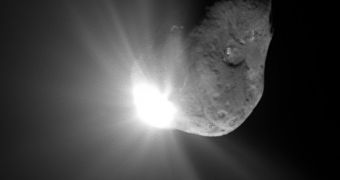Launched in January 2005, the Deep Impact space probe was the first spacecraft ever to probe the interior of a comet's nucleus, by sending a impactor slamming right into it. Previous missions such as Giotto and Stardust were employed only to make fly-by passes through the vicinity of the nucleus of the comets that they were studying, taking pictures and making observations of the cometary material from a distance.
Seven months after it was launched into space, the Deep Impact mothership detached the impactor and sent it towards the nucleus of the comet 9P/Tempel, resulting in an energy release equivalent to about five tons of dynamite that sent a cloud of dust over the surface of the comet six times brighter than it usually is, which provided valuable information about the density of the body and its general composition.
Now the Deep Impact spacecraft received the mission to start a journey of about two and a half years towards the comet Hartley 2, which consists of two stages. The first one is to study five close stars in the hope that it will find evidence of Earth-like planets after which it will execute a fly-by near Hartley 2 to study its general features.
Engineers at NASA originally wanted to take the spacecraft towards the comet Boethin, but they soon realized that they cannot predict its orbit fast enough and could potentially lose the probe so they decided to study a known comet instead. Nevertheless, the mission to the Hartley 2 comet will be carried out in much the same way as the one made by the previous probes, since Deep Impact has been equipped with only one impactor body.
Maneuvers to redirect the probe have already begun and include a gravitational swing assisted by the planet on December 31. Once it gets to the comet it will use its eXtended Investigation tool to study the surface of Hartley 2 by observing the outburst of gas from its core as it closes in on the Sun.
The planetary detection mission will begin in the late January next year and will use two detection techniques, one based on comparing multiple images of the star it is observing, in the hope that it can filter out a distinctive signature left behind by the passing of a planet in front of the star from the probe's perspective, and the second, by observing the wobble in the star's position, a clear indication of the planet's gravitational influence on the star.
It will make three trips around the Sun before it will be able to intercept the comet and will make a journey that will take it about 18 times farther than the distance from Earth to the Sun, equivalent to about 2.5 billion kilometers.

 14 DAY TRIAL //
14 DAY TRIAL //